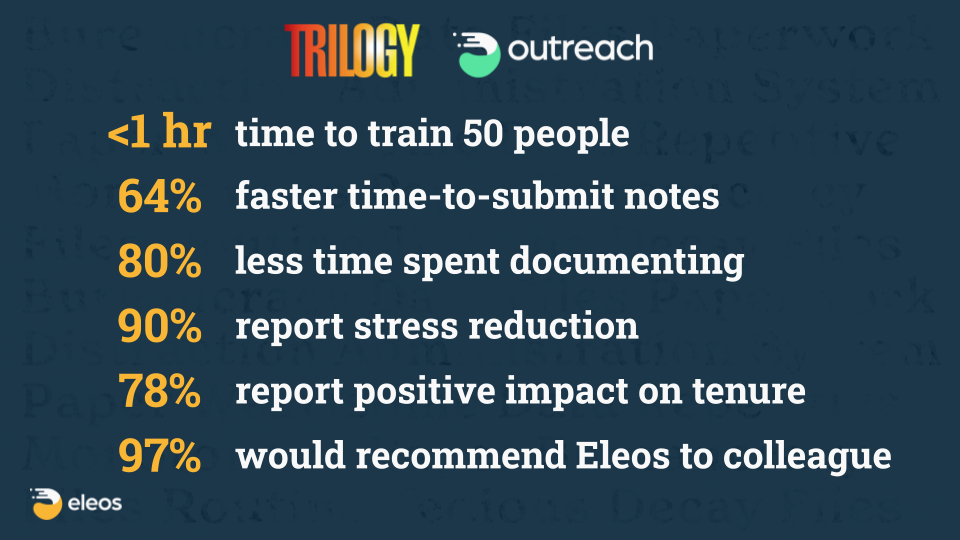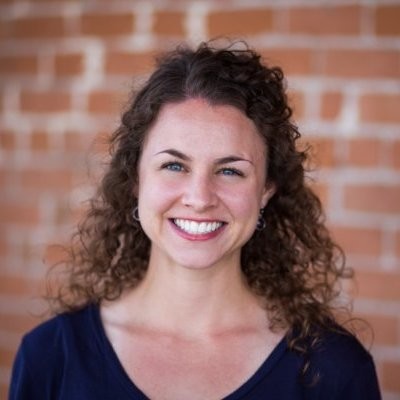Like many behavioral health workers, Darren Dunham loves what he does. What he doesn’t love is the work that comes after his workday. And until recently, that work was constantly stretching into the late evening and early morning hours.
“I really like this kind of work, but it’s very intense as far as giving quality services and being able to meet documentation deadlines and direct service goals,” Dunham, a team leader at Chicago-based Trilogy, said during a recent webinar with Eleos Health. “And I often, on a daily basis, would find myself at the end of the day, after hours, doing notes and stretching out and waking up the next morning—and finishing more notes. It was all about notes, notes, notes.”
Dunham’s experience wasn’t unique—particularly among Trilogy’s field-based providers and case managers.
Falling Behind and Burning Out
“We were experiencing some challenges related to documentation,” Amanda Rankin, Trilogy COO, said during the same webinar. “Trilogy primarily provides community-based services, including ACT and CST services, and that means our staff are driving around a lot—and they don’t have a whole lot of time between sessions to do their documentation.”
That meant paperwork often piled up—and stress piled on for providers who already had enough on their plates.
“It was somewhat stressful trying to practice self-care, which my supervisors were constantly encouraging me to do,” Dunham said. “It was difficult.”
According to Rankin, staff members were spending about 15–20 minutes writing each note—fairly standard for a one-hour client session. But, as she explained, “When you consider that for six to eight interactions per day, our staff were spending two-ish hours a day on note-writing, and that was just entirely too much.”
For some staff members, the struggle to keep up with documentation tasks was so intense that it drove them to leave their jobs. And in the midst of a nationwide behavioral health provider shortage and a hiring market that’s growing more competitive by the day, Trilogy couldn’t afford that kind of turnover.
“I think there’s also an emotional burden of note-writing,” Rankin said. “If you don’t have the ability to do it every day and stay on top of it, it’s easy to fall behind. And when that happens, I think all too often, staff would get behind, feel overwhelmed, and just leave the organization.”
Finding a Better Way
Thomas Edison once said, “There’s a better way to do it. Find it.”
That’s exactly what Rankin set out to do as she started untangling the root causes of Trilogy’s documentation backlog and staff retention issues.
When she discovered Eleos Health, she was intrigued by the platform’s automated documentation features. But after a few discussions with the Eleos team, she realized that the existing product line—though great for office-based behavioral health providers—didn’t really meet the needs of on-the-go providers and case managers, who spend very little time at their desks.
How Trilogy Helped Bring Eleos Outreach to Life
The more she talked with the Eleos team, the more they all realized there was a huge opportunity in front of them—an opportunity to meet a gaping need for documentation technology tailored to the field-based provider workflow.
“What we really needed to do was identify the problems that our outreach staff were facing and develop a product to meet those workflows,” Rankin explained. “So specifically, a tool that was accessible on a phone that provided an easy, quick solution for data entry.”
Fast-forward a little over a year, and the teams had built a full-fledged documentation automation solution for on-the-go behavioral health staff: Eleos Outreach.
“It’s been a completely collaborative process from the beginning,” Rankin said. “We worked with Eleos back and forth on this vision, and we developed this product.”
Focusing on Workflow
Rankin knew that Trilogy’s successful adoption of Eleos Outreach hinged on the product’s ability to integrate seamlessly into existing staff workflows.
Shon Cohen, the Product Manager for Eleos Outreach, was 100% on the same page. “If you’re not embedded within the user’s workflow, it doesn’t matter how good the quality of the note is,” Cohen said.
To get a more authentic feel for that workflow, Cohen and the Eleos team decided to put themselves in the users’ shoes and experience their documentation process firsthand.
“I think you need to feel the pain yourself of finishing your day and then needing to submit notes,” Cohen said. “So we actually submitted around 800 notes ourselves, just to understand the burden around writing those notes.”
Based on their learnings—and continued collaboration with Trilogy—Cohen and the Eleos team created a mobile-first solution that connects to the provider’s EHR without requiring them to actually log into the EHR from the field.
How Eleos Outreach Works
As Christian Nupp, Senior Director of Solutions Engineering at Eleos Health, explained in a live demo of Eleos Outreach during the webinar, the basic steps for documenting a session on-the-go are:
- The provider receives an SMS message on their phone with a link to launch the web-based Eleos Outreach application.
- The application prompts the provider to select from pre-filled options for services, diagnoses, and symptoms. The options shown to the provider build off of their previous selections. So, for example, if the provider selects “anxiety and depression” for the diagnosis, they’ll see anxiety and depression symptoms.
- The note is populated based on the provider’s selections as well as previous note history. The provider can then type in details specific to the client’s session—or even use talk-to-text.
- The provider reviews the note and sends it to the EHR with the tap of a button.
For most providers, this process takes about 2–3 minutes, and they can do it anywhere they have web access—either through a WiFi connection or cellular data.
Check out the video below for a quick overview of the Eleos Outreach product. (And be sure to watch the on-demand webinar recording for a full demo!)
Feeling Relief
For Rankin, the real moment of truth was the day the Eleos implementation team introduced Trilogy providers to the product. She could see the excitement in their faces as they logged into Eleos Outreach for the first time.
“They all had notes from the previous day, so they had a chance to do a note right there during the training and watch it get moved into CareLogic where they could then sign it before the training was over,” Rankin said. “It was a super-simple, intuitive experience.”
In fact, she joked that they only needed about 15 minutes of the one-hour training session they had scheduled—which left plenty of time for celebrations.
“I wish all new technology implementation was this easy,” Rankin said.
How Eleos Outreach Makes a Difference at Trilogy

Prior to adopting Eleos Outreach, Trilogy staff reported spending about 10–20 minutes writing each of their clinical notes. With Eleos Outreach, it takes them about 3 minutes to draft a note and another few minutes to add the details specific to the service provided. All in all, they’ve decreased documentation time by around 80%. They’ve also improved their time to submission by 64%.
More importantly, 90% of providers using Eleos Outreach reported a reduction in job-related stress, with nearly 8 in 10 also indicating that Eleos Outreach would positively impact the length of their tenure on an Outreach Team at Trilogy.
Forging a New Path for the Future
One piece of advice Rankin would give any other behavioral health leader considering Eleos Outreach: It’s not a replacement for the provider’s knowledge and experience.
“I think it’s really important to understand that this is not an automated workflow—it’s an augmented workflow,” she said. “That means staff are ultimately responsible for the note that they sign their name to, and I wouldn’t want it any other way.”
So, while it reduces the mental burden of using the right clinical language or documenting in a way that supports coding and billing, the provider still has to exercise good judgment and add the details necessary to paint a full picture of the client’s experience and progress.
Furthermore, Rankin cautions against framing the ROI of a tool like Eleos Outreach around metrics like productivity—because doing so defeats the purpose of positioning it as a differentiator for your workforce.
“I’ve talked to a lot of organizations about what they see as the value of something like Eleos Outreach, and I’ve run into more than one executive who said, ‘This is going to allow me to increase productivity expectations of my staff,’” Rankin recalled. “Trilogy does not approach this in that way at all. In fact, we see this as an opportunity to make a very challenging job less burdensome for our staff. There is ROI to be had with this product, but staff productivity is certainly not where I would go after ROI.”
For Dunham, the ROI is clear: a healthier work-life balance and more time and energy for what truly matters.
“There is absolutely no after-hours note-writing anymore,” Dunham said. “I’m able to focus on self care, and I’m able to go back to school full time as well. So, this has really changed my life tremendously. I love it, and I can’t say enough about it.”
Want to learn more about Eleos Outreach? Watch the on-demand video recording of our webinar with Trilogy here.
Ready to see what Eleos Outreach can do for your behavioral health organization? Request a personalized demo here.
